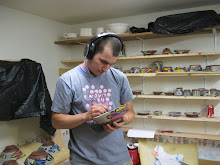I would like to start this post by saying that I am
very thankful to the Northern Clay Center and the Jerome Foundation for giving
me the opportunity to pursue this project. This past spring I was chosen to
recieve a 2012 Jerome Ceramic Artists Project Grant awarded by the Northern
Clay Center.
My project for this grant was to make a body of work using slips and
glazes fired to cone 3 with terra cotta. I did not have much experience with
low fire clays or glazes as I had worked primarily with porcelain bodies firing
in reduction to cone 10.
I wanted to pursue firing to cone 3 as I could easily use an electric
kiln and save a great amount of energy compared to firing at cone 10 with gas.
I knew I wasn’t going to have easy access to a gas kiln and needed to be more independent if I wanted to continue making pots. I also wanted to be more environmentally conscious of the
materials and energy I use. By using an earthenware body the clay becomes very
vitreous firing to cone 3 and hotter, which I believe is stronger than
stoneware or porcelain at cone 10. When I flick one of these cone 3 pots with my fingernail it
has a sweet sounding glassy ring to it.
I started by doing some melt tests of frits, Gillespie B, and neph sye while firing the clay to
temperatures ranging from cone 1 to cone 5. I tested different slip and glaze recipes from fellow
potters as well as mixing blends during these first firings. I found a lot of issues
with these firings, a minimal amount crawling and/or crazing, but many over
fired or under fired glazes. The
amount and type of frit in these glazes made a substantial difference in the
outcome. I decided to use frit
3195 for glaze development as it has the highest melting point compared to 3110, 3124, and 3134 frits.
 |
| some of the better slip and glaze tests |
I was fortunate to find a couple of good clear bases that fired nicely
at cone 3. The clay body I decided
to use is low fire red from Continental Clay as I know many potters who have
used it for years. It is a high iron earthenware body that can be fired to cone
4 easily. At cone 5 I noticed a substantial amount of bloating with this
clay. I bisque fire to cone 07 as
that seems to be sufficient to keep from excess off gassing during the glaze
firing.
I hope that this has been a helpful post for some of you. I know I am
not an organized writer or photographer, but hope to influence more clay
artists to question their footprint. I thought I would always use porcelain but
I have gone “dirty” and don’t see myself going back.
That is it for today’s post. I will be back soon to share more of the
results I have uncovered over the past months. Thank you for your time.



I just discovered your work through Etsy and came over here to read your blog. Your new work is fabulous! Although I have not done reduction or high firings since university, having stayed at cone 6, I have recently been very attracted to red clay so am sure there will be at least a red addition to my work in the future. Your beautiful cone 3 work is very inspiring! Maybe I'll do some experimenting above 04 when I finally get into the red clay. I look forward to your future posts. And congratulations on your grant award, it looks well deserved!
ReplyDelete